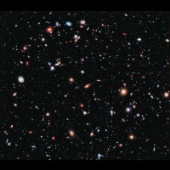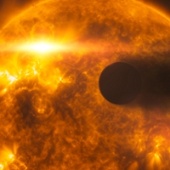ESA Science & Technology - News Archive
News archive
News archive
The NASA/ESA Hubble Space Telescope is one of the most powerful available to astronomers, but sometimes it too needs a helping hand. This comes in the form of Einstein's general theory of relativity, which makes galaxy clusters act as natural lenses, amplifying the light coming from very distant galaxies.
Published: 5 March 2013
The Hubble Space Telescope has produced a time-lapse movie of a mysterious protostar that behaves like a flashing light.
Published: 7 February 2013
The NASA/ESA Hubble Space Telescope - with a little help from an amateur astronomer - has produced one of the best views yet of nearby spiral galaxy Messier 106. Located a little over 20 million light-years away, practically a neighbour by cosmic standards, Messier 106 is one of the brightest and nearest spiral galaxies to our own.
Published: 5 February 2013
Nearly 200 000 light-years from Earth, in the Large Magellanic Cloud, newly formed stars light up gas clouds in a riot of colours, visible in this image from the Hubble Space Telescope.
Published: 17 January 2013
How fast people age may have more to do with their lifestyle than with how old they actually are. A new study with the Hubble Space Telescope reveals that the same is true of star clusters.
Published: 19 December 2012
The NASA/ESA Hubble Space Telescope celebrates the holiday season with a striking image of the planetary nebula NGC 5189. The intricate structure of the stellar eruption looks like a giant and brightly coloured ribbon in space.
Published: 18 December 2012
Astronomers using the NASA/ESA Hubble Space Telescope have uncovered seven primitive galaxies from a distant population that formed more than 13 billion years ago. In the process, their observations have put forward a candidate for the record for the most distant galaxy found to date (at redshift 11.9), and have shed new light on the earliest...
Published: 12 December 2012
Bright pink nebulae almost completely encircle a spiral galaxy in this NASA/ESA Hubble Space Telescope image of NGC 922. The ring structure and the galaxy's distorted spiral shape result from a smaller galaxy scoring a cosmic bullseye, hitting the centre of NGC 922 some 330 million years ago.
Published: 6 December 2012
By combining the power of the NASA/ESA Hubble Space Telescope, NASA's Spitzer Space Telescope and one of nature's zoom lenses, astronomers have found what is probably the most distant galaxy yet seen in the Universe. The object offers a peek back into a time when the Universe was only 3 percent of its present age of 13.7 billion years.
Published: 15 November 2012
Astronomers using the NASA/ESA Hubble Space Telescope have obtained a remarkable new view of a whopper of an elliptical galaxy, with a core bigger than any seen before. There are two intriguing explanations for the puffed up core, both related to the action of one or more black holes, and the researchers have not yet been able to determine which...
Published: 25 October 2012
Astronomers using Hubble have studied a giant filament of dark matter in 3D for the first time. Extending 60 million light-years from one of the most massive galaxy clusters known, the filament is part of the cosmic web that constitutes the large-scale structure of the Universe.
Published: 16 October 2012
Astronomers have assembled a new, improved portrait of our deepest-ever view of the Universe. Called the eXtreme Deep Field, or XDF, the photo was assembled by combining ten years of Hubble Space Telescope observations taken of a patch of sky within the original Hubble Ultra Deep Field. The XDF is a small fraction of the angular diameter of the...
Published: 25 September 2012
Two very different galaxies feature in this family portrait taken by the Hubble Space Telescope, together forming a peculiar galaxy pair called Arp 116.
Published: 6 September 2012
A team of astronomers using the NASA/ESA Hubble Space Telescope has discovered a fifth moon orbiting the icy dwarf planet Pluto.
Published: 11 July 2012
Astronomers have used Hubble to study some of the smallest and faintest galaxies in our cosmic neighbourhood. These galaxies are fossils of the early Universe: they have barely changed for 13 billion years.
Published: 10 July 2012
The NASA/ESA Hubble Space Telescope has captured a new image of Herbig-Haro 110, a geyser of hot gas flowing from a newborn star.
Published: 3 July 2012
Astronomers using the Hubble Space Telescope have seen dramatic changes in the upper atmosphere of a faraway planet. The observations give a tantalising glimpse of the changing climates and weather on planets outside our Solar System.
Published: 28 June 2012
The European science archive for the NASA/ESA Hubble Space Telescope has been transferred to ESA's European Space Astronomy Centre (ESAC) in Villanueva de la Cañada near Madrid, Spain.
Published: 22 June 2012
The Hubble Space Telescope has produced a highly detailed image of a pair of overlapping galaxies called NGC 3314
Published: 14 June 2012
The NASA/ESA Hubble Space Telescope has made detailed observations of the dwarf galaxy NGC 2366. While it lacks the elegant spiral arms of many larger galaxies, NGC 2366 is home to a bright, star-forming nebula and is close enough for astronomers to discern its individual stars.
Published: 10 May 2012
—
20 Items per Page




















